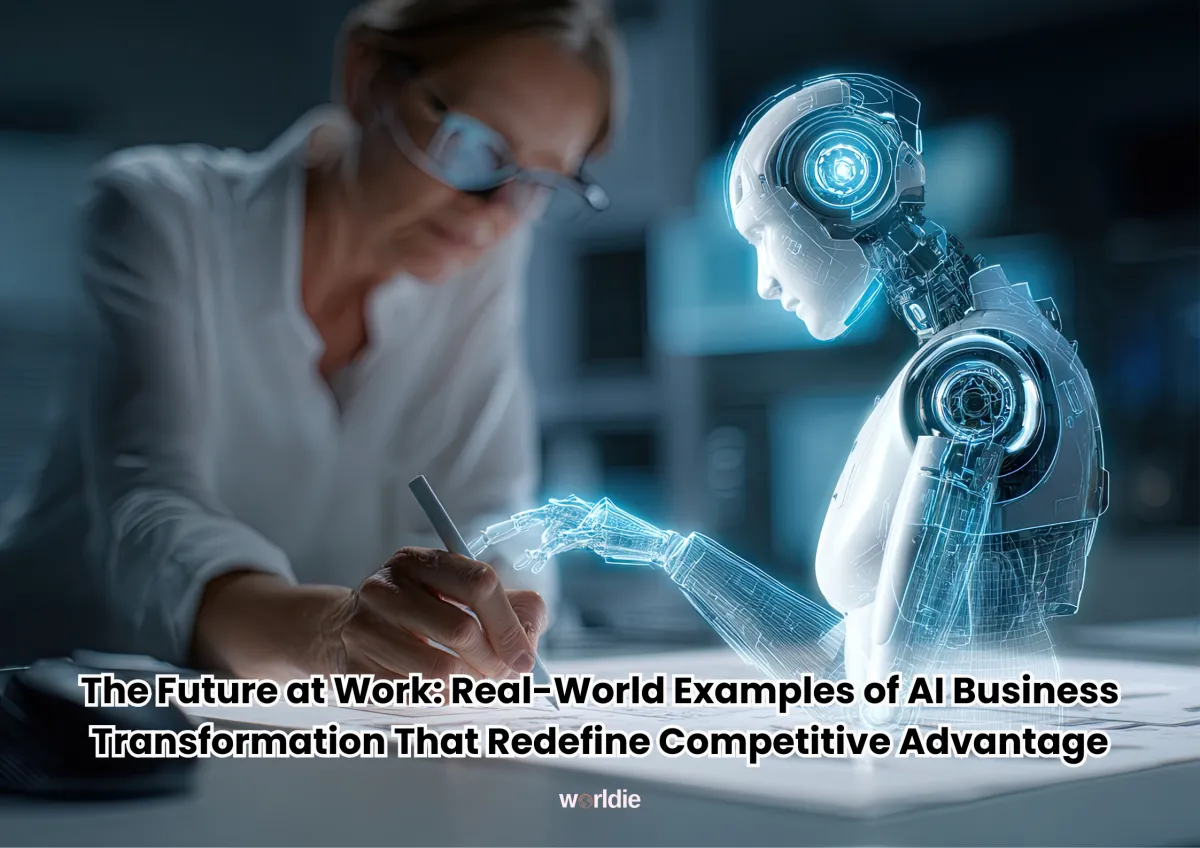
The Future at Work: Real-World Examples of AI Business Transformation That Redefine Competitive Advantage
The phrase “real-world examples of AI business transformation” isn’t just a buzzworthy headline—it reflects how artificial intelligence is reshaping how businesses operate, make decisions, and grow. Across industries, companies are integrating AI not just as a tool, but as an operational backbone that redefines efficiency, innovation, and scalability.
From predictive analytics that power smarter marketing campaigns to automation systems that cut operational costs by half, AI has become the growth engine behind today’s fastest-scaling organizations. But the real story isn’t about algorithms or data science—it’s about the transformation of entire business models and the creation of new revenue pathways.
At Worldie AI, we specialize in designing, building, and deploying AI systems that don’t just improve workflow—they redefine how businesses think about growth and value creation. Let’s unpack how this transformation is unfolding across industries, what challenges leaders are facing, and how companies are unlocking measurable ROI through intelligent systems.
Understanding What AI Business Transformation Really Means
AI business transformation isn’t about adding a chatbot or automating tasks—it’s about embedding intelligence into the heart of your operations. It’s when data, processes, and decision-making converge into a self-optimizing system that learns, predicts, and adapts.
For many organizations, transformation begins with identifying where friction lives. It could be inefficiencies in supply chain management, inconsistent customer experiences, or missed opportunities in revenue forecasting. AI steps in as a strategic amplifier—turning these pain points into predictable and scalable systems.
At its core, AI transformation means re-engineering business logic to make intelligence a continuous loop rather than a one-time fix.
Why Traditional Business Operations Are No Longer Enough
Most organizations today still operate with fragmented data systems, manual reporting, and reactive decision-making. Teams spend hours managing workflows that could be automated, and executives often make decisions based on static reports instead of real-time insights.
This traditional model worked when growth was linear. But in a digital economy where competition moves at machine speed, businesses that rely on outdated processes fall behind.
The inefficiencies are clear:
Marketing teams struggle to personalize outreach at scale.
Sales teams lose opportunities due to slow data syncing.
Operations departments can’t predict supply chain shifts.
Finance teams work from historical data instead of live analytics.
AI transforms this static model into a dynamic one—where insights are instant, patterns are detected before humans notice them, and every decision compounds growth.
Real-World Examples of AI Business Transformation in Action
Across industries, AI has already proven its transformative power. But what makes these examples powerful isn’t just the technology—it’s the strategy behind implementation.
1. Amazon: Predictive Logistics and Recommendation Systems
Amazon’s transformation is driven by predictive analytics and machine learning. Their AI systems anticipate what customers will buy before they do, optimizing logistics and inventory down to individual zip codes. This predictive capability turns customer data into immediate operational action, reducing delivery times and boosting conversions.
The same recommendation engine that drives product discovery has been trained over billions of transactions, personalizing shopping at an individual level. The result is higher customer loyalty and revenue growth powered by data intelligence.
2. Netflix: Decision Intelligence in Content and Engagement
Netflix doesn’t just stream videos—it runs one of the most sophisticated AI-driven personalization engines on the planet. Machine learning models analyze viewer behavior, time spent on scenes, and even pause points to predict what each user will watch next.
This data intelligence fuels not only engagement but also billion-dollar decisions about what original content to produce. By predicting audience preferences, Netflix reduces creative risk and maximizes return on every production investment.
3. Tesla: Autonomous Systems and Continuous Learning
Tesla’s business transformation centers around autonomy and data feedback loops. Every Tesla vehicle acts as a live data source, feeding millions of data points into machine learning systems that improve driving performance across the entire fleet.
This AI-driven model redefines value creation. Tesla isn’t just selling vehicles—it’s building a self-learning product ecosystem. Each software update improves user experience and reinforces Tesla’s advantage as a mobility intelligence company rather than a car manufacturer.
4. Spotify: Predictive Customer Experience
Spotify’s AI engine personalizes music recommendations, but its deeper transformation lies in predictive engagement. By anticipating what users want to hear next, Spotify extends listening time and ad engagement rates.
This AI-driven personalization allows Spotify to optimize advertising, pricing models, and artist exposure—effectively transforming a simple streaming service into a data intelligence network that benefits listeners, advertisers, and creators alike.
5. Small and Scaling Businesses: AI in Everyday Operations
While the giants dominate headlines, AI transformation is just as attainable for startups and mid-sized brands.
E-commerce stores are now using AI to predict customer churn, optimize pricing dynamically, and automate fulfillment. Marketing agencies deploy AI to score leads, craft data-driven campaigns, and eliminate wasted ad spend. Even service businesses use AI-powered virtual assistants to automate client scheduling, invoicing, and customer support.
Worldie AI helps companies like these move beyond simple automation—into a structured, intelligent growth infrastructure that operates predictively, not reactively.
The Worldie AI Approach: Design → Build → Release
True transformation doesn’t come from isolated tools. It requires architecture.
Worldie AI applies a strategic, three-phase approach designed for long-term scalability:
Design – We start by mapping the growth infrastructure, identifying friction points, and defining where intelligence can create measurable ROI.
Build – Our team engineers data pipelines, custom automation models, and decision systems aligned to your business goals.
Release – Once deployed, systems evolve through adaptive learning, turning every workflow into a continuous feedback loop that compounds results over time.
This end-to-end approach ensures that AI isn’t just an add-on—it becomes a strategic pillar that redefines performance across the organization.
Challenges in AI Deployment—and How to Overcome Them
AI transformation is powerful, but not without challenges. The most common barriers include:
Data Fragmentation – Businesses often have siloed or incomplete datasets that limit AI accuracy.
Integration Complexity – Legacy systems are not always compatible with modern AI frameworks.
Team Readiness – Employees need proper training to trust and interact with AI outputs.
ROI Tracking – Many companies struggle to connect AI outcomes directly to revenue.
Worldie AI addresses these challenges by aligning every system with business metrics. Instead of implementing AI for the sake of modernization, we focus on clarity: measurable impact, consistent improvement, and transparent performance tracking.
Metrics That Define AI-Driven Success
AI transformation success is not about the number of tools you deploy—it’s about measurable results. Common indicators include faster decision-making, reduced costs, higher revenue per employee, improved lead conversion rates, and better customer retention.
The most successful AI projects share one trait: a clear feedback system that measures outcomes and continuously refines algorithms. Worldie AI’s infrastructures are built to make this measurable loop part of your daily operations.
Real-World Transformations Enabled by Worldie AI
Worldie AI has worked with growth-focused businesses that wanted to modernize operations, improve client retention, and increase profitability.
In one case, a regional logistics firm struggled with delivery inefficiencies. After implementing AI-based route optimization, delivery times dropped by 30% and fuel costs by 18%.
Another company—a SaaS brand—used predictive analytics from Worldie AI to forecast churn and personalize renewal campaigns. Within four months, retention increased by 22%.
These outcomes aren’t theoretical—they’re engineered through structured AI systems that create sustainable, data-driven growth.
Why AI Is Now a Non-Negotiable Growth Engine
AI is no longer optional—it’s the infrastructure layer behind scalable, adaptive businesses. It doesn’t just automate; it amplifies intelligence.
Organizations that embrace AI transformation today are setting the foundation for exponential compounding growth. Those that hesitate risk being left behind as industries shift toward predictive and adaptive operations.
Worldie AI’s mission is to help businesses move from experimentation to execution—turning potential into performance.
FAQs: Real-World Examples of AI Business Transformation
1. How can AI transformation create measurable revenue growth for my business?
AI helps convert data into real-time decision systems that reduce inefficiencies, cut costs, and identify new revenue opportunities. From predictive sales forecasting to intelligent pricing, AI systems amplify profitability by optimizing performance across every stage of the business cycle.
2. What industries benefit the most from AI-driven transformation?
AI is adaptable across industries—from retail, logistics, and healthcare to finance, marketing, and SaaS. Any business that generates data and relies on human-driven decision-making can gain exponential efficiency from AI integration.
3. What makes Worldie AI different from other AI implementation firms?
Worldie AI builds AI Growth Infrastructures, not just tools. We design, build, and release integrated systems that align data, automation, and intelligence to your business model—ensuring measurable and scalable ROI.
4. How long does it take to see ROI from AI implementation?
Timelines vary by scope and data readiness. Some businesses start seeing measurable gains within 60 to 90 days after system deployment, while full-scale ROI compounds over the first six to twelve months as models learn and adapt.
5. Can smaller startups or mid-sized businesses afford AI transformation?
Yes. Worldie AI offers modular system architectures designed for scalability. This means smaller organizations can start with focused implementations—like predictive lead scoring or workflow automation—and expand as revenue grows.

